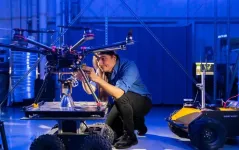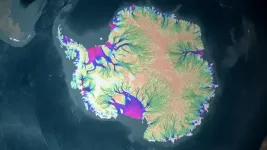(Press-News.org) WINSTON-SALEM, N.C. – March 13, 2025 – A study from researchers at Wake Forest University School of Medicine highlights a new approach in addressing conductive hearing loss. A team of scientists, led by Mohammad J. Moghimi, Ph.D., assistant professor of biomedical engineering, designed a new type of hearing aid that not only improves hearing but also offers a safe, non-invasive alternative to implantable devices and corrective surgeries.
The study recently published in Communications Engineering, a Nature Portfolio journal.
Conductive hearing loss, which most commonly happens in childhood, occurs when sounds do not reach the inner ear. Sound waves are blocked in the outer or middle ear due to ear infections, blockages or structural abnormalities.
“Treatment for conductive hearing loss can include corrective surgeries and implantable hearing aids, which can be very invasive, especially for pediatric patients,” Moghimi said. “Flexible hearing aids offer a noninvasive alternative.”
To produce vibrations strong enough to reach the cochlea, the part of the inner ear responsible for hearing, the research team designed a flexible hearing aid. The device uses micro-epidermal actuators to create vibrations on the skin behind the ear, which then travel directly to the inner ear, bypassing the ear canal.
For the study, 10 participants between the ages of 19 and 39 wore earplugs and earmuffs to simulate conductive hearing loss. Researchers then tested arrays of the actuators to enhance the vibration strength, improve the quality of sounds and control the direction of the vibrations.
“We found that using an array of these actuators, rather than a single one, significantly enhances the strength and quality of the vibrations, leading to better hearing outcomes,” Moghimi said.
Moghimi also noted that improving hearing in children can reduce delays in language and speech development and boost educational development.
“This technology has the potential to improve the quality of life for children with hearing impairments and transform the way we approach pediatric hearing aids,” Moghimi said.
The research team will next focus on a larger study to further evaluate the efficacy and safety of the device in children and adults.
END
Study highlights noninvasive hearing aid
New type of hearing aid using an array of micro-epidermal actuators can significantly improve the hearing experience for patients with conductive hearing loss
2025-03-13
ELSE PRESS RELEASES FROM THIS DATE:
NASA taps UTA to shape future of autonomous aviation
2025-03-13
Envision a world where unmanned aircraft deliver goods to your front door and transport passengers in flying taxis, cargo planes cross continents carrying vital trade goods, and fighter jets patrol battle zones—all without a human pilot at the controls.
Those scenarios might seem a bit far-fetched now, but researchers are working diligently to develop these aircraft and ensure they operate safely. That’s why NASA has awarded a $1 million grant through its University Leadership Initiative (ULI) to a team from The University of Texas at Arlington Research ...
Mutations disrupt touch-based learning, study finds
2025-03-13
You may scarcely notice it, but much of what you do every day requires your brain to engage in perceptual learning. To safely cross an intersection or quickly retrieve something from your bag, you depend upon your brain to first assign meaning to sensory input from your eyes or fingertips.
Usually, it’s effortless.
Research from The Herbert Wertheim UF Scripps Institute for Biomedical Innovation & Technology shows a gene called Syngap1 enables touch-based perception, while certain mutations can lead to mixed signals. The research was made possible through grants from the National Institute of Mental Health and the National Institute ...
Misha lived in zoos, but the elephant’s tooth enamel helps reconstruct wildlife migrations
2025-03-13
Teeth recovered from a beloved zoo elephant that died in 2008 are helping University of Utah geologists develop a method for tracking the movements of large herbivores across landscapes, even for animals now extinct, such as mastodons and mammoths.
Outlined in recently published findings, the technique analyzes isotope ratios of the element strontium (Sr), which accumulates in tooth enamel. For large plant-eating land mammals, the relative abundance of two strontium isotopes in teeth and tusks ...
Eat better, breathe easier? Research points to link between diet, lung cancer
2025-03-13
For cancers of organs like the liver, the long-term impact of our diet has been well studied — so much so that we have guidance about red meat, wine and other delicacies.
A new study from researchers at University of Florida Health looks at another kind of organ whose cancer risk may be affected by poor diet: the lungs. The study was funded by several National Institutes of Health grants and a collaboration between the University of Kentucky's Markey Cancer Center and the UF Health Cancer Center.
“Lung ...
Mesozoic mammals had uniform dark fur
2025-03-13
The early mammals that lived alongside the dinosaurs upwards of 150 million years ago (mya) were likely covered in dark and dusky greyish-brown fur, according to a quantitative reconstruction of Mesozoic mammal coloration, hinting at their shrouded and nocturnal nature. The findings, drawn from a comparative analysis of fossilized melanosomes, provide insights into the ecology and evolutionary history of early mammals. From communication to camouflage, animal coloration plays an important role in numerous behavioral ecological ...
Wartime destruction of Kakhovka Dam in Ukraine has long-term environmental consequences
2025-03-13
The deliberate destruction of the Kakhovka Dam in Ukraine during the Russo-Ukrainian war unleashed a hidden environmental crisis, destroying ecosystems and releasing polluted sediments into downstream water systems, according to a new study. The findings provide critical new insights into the prolonged ecological risks of strategic dam destruction during warfare and the effects that may persist for years beyond war. “Our work highlights the far-reaching environmental consequences of the [Kakhovka Dam] destruction and raises concerns not only about the use of water as a weapon, but also about ...
NIH’s flat 15% funding policy is misguided and damaging
2025-03-13
The U.S. National Institutes of Health’s recent decision to impose a 15% cap on facilities and administrative (F&A) cost reimbursements threatens to undermine the quality and sustainability of university research by slashing indirect funding by $4 billion. In a Policy Forum, Jeongwon Choi and colleagues argue that this policy is fundamentally flawed, as it disregards the essential role of indirect costs, such as infrastructure, utilities, and administrative support, in enabling scientific research. The current system, governed by rigorous federal oversight and audits, ensures that F&A reimbursements are fair and necessary, varying across institutions based on actual costs. NIH’s ...
AI reveals new insights into the flow of Antarctic ice
2025-03-13
As the planet warms, Antarctica’s ice sheet is melting and contributing to sea-level rise around the globe. Antarctica holds enough frozen water to raise global sea levels by 190 feet, so precisely predicting how it will move and melt now and in the future is vital for protecting coastal areas. But most climate models struggle to accurately simulate the movement of Antarctic ice due to sparse data and the complexity of interactions between the ocean, atmosphere, and frozen surface.
In a paper published March 13 in Science, researchers at Stanford University used machine learning to analyze high-resolution ...
Scientists solve decades-long Parkinson’s mystery
2025-03-13
WEHI researchers have made a huge leap forward in the fight against Parkinson’s disease, solving a decades-long mystery that paves the way for development of new drugs to treat the condition.
First discovered over 20 years ago, PINK1 is a protein directly linked to Parkinson’s disease – the fastest growing neurodegenerative condition in the world. Until now, no one had seen what human PINK1 looks like, how PINK1 attaches to the surface of damaged mitochondria, or how it is switched on.
In ...
Spinning, twisted light could power next-generation electronics
2025-03-13
Researchers have advanced a decades-old challenge in the field of organic semiconductors, opening new possibilities for the future of electronics.
The researchers, led by the University of Cambridge and the Eindhoven University of Technology, have created an organic semiconductor that forces electrons to move in a spiral pattern, which could improve the efficiency of OLED displays in television and smartphone screens, or power next-generation computing technologies such as spintronics and quantum computing.
The semiconductor they developed emits circularly polarised ...
LAST 30 PRESS RELEASES:
Injectable breast ‘implant’ offers alternative to traditional surgeries
Neuroscientists devise formulas to measure multilingualism
New prostate cancer trial seeks to reduce toxicity without sacrificing efficacy
Geometry shapes life
A CRISPR screen reveals many previously unrecognized genes required for brain development and a new neurodevelopmental disorder
Hot flush treatment has anti-breast cancer activity, study finds
Securing AI systems against growing cybersecurity threats
Longest observation of an active solar region
Why nail-biting, procrastination and other self-sabotaging behaviors are rooted in survival instincts
Regional variations in mechanical properties of porcine leptomeninges
Artificial empathy in therapy and healthcare: advancements in interpersonal interaction technologies
Why some brains switch gears more efficiently than others
UVA’s Jundong Li wins ICDM’S 2025 Tao Li Award for data mining, machine learning
UVA’s low-power, high-performance computer power player Mircea Stan earns National Academy of Inventors fellowship
Not playing by the rules: USU researcher explores filamentous algae dynamics in rivers
Do our body clocks influence our risk of dementia?
Anthropologists offer new evidence of bipedalism in long-debated fossil discovery
Safer receipt paper from wood
Dosage-sensitive genes suggest no whole-genome duplications in ancestral angiosperm
First ancient human herpesvirus genomes document their deep history with humans
Why Some Bacteria Survive Antibiotics and How to Stop Them - New study reveals that bacteria can survive antibiotic treatment through two fundamentally different “shutdown modes”
UCLA study links scar healing to dangerous placenta condition
CHANGE-seq-BE finds off-target changes in the genome from base editors
The Journal of Nuclear Medicine Ahead-of-Print Tip Sheet: January 2, 2026
Delayed or absent first dose of measles, mumps, and rubella vaccination
Trends in US preterm birth rates by household income and race and ethnicity
Study identifies potential biomarker linked to progression and brain inflammation in multiple sclerosis
Many mothers in Norway do not show up for postnatal check-ups
Researchers want to find out why quick clay is so unstable
Superradiant spins show teamwork at the quantum scale
[Press-News.org] Study highlights noninvasive hearing aidNew type of hearing aid using an array of micro-epidermal actuators can significantly improve the hearing experience for patients with conductive hearing loss




